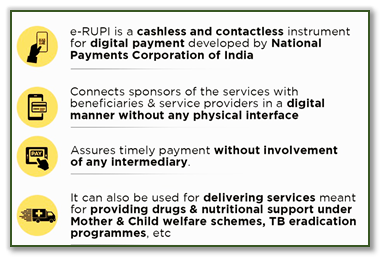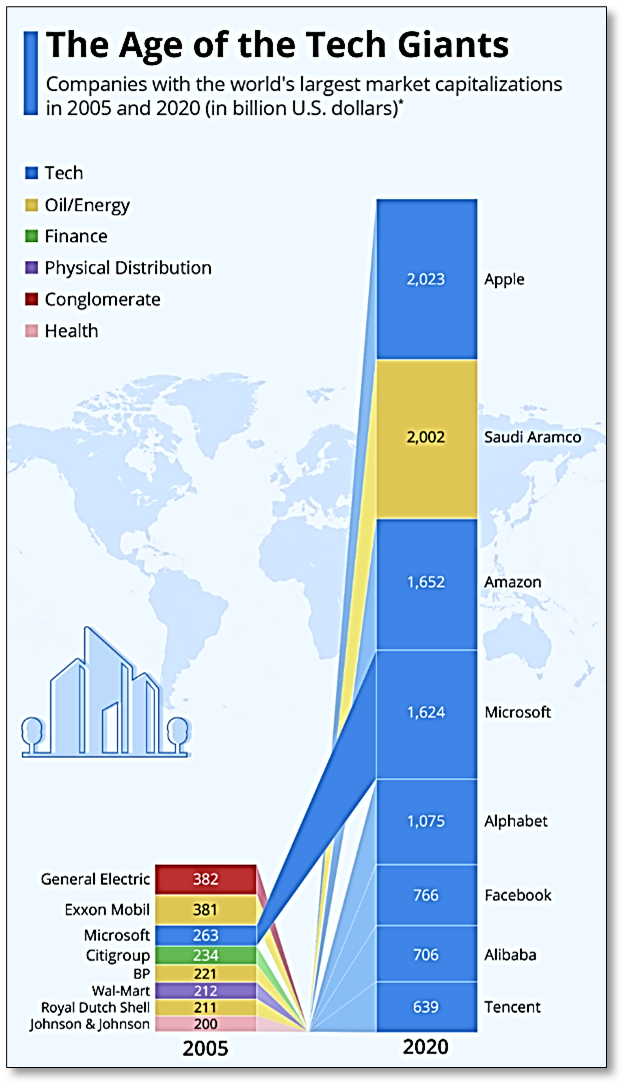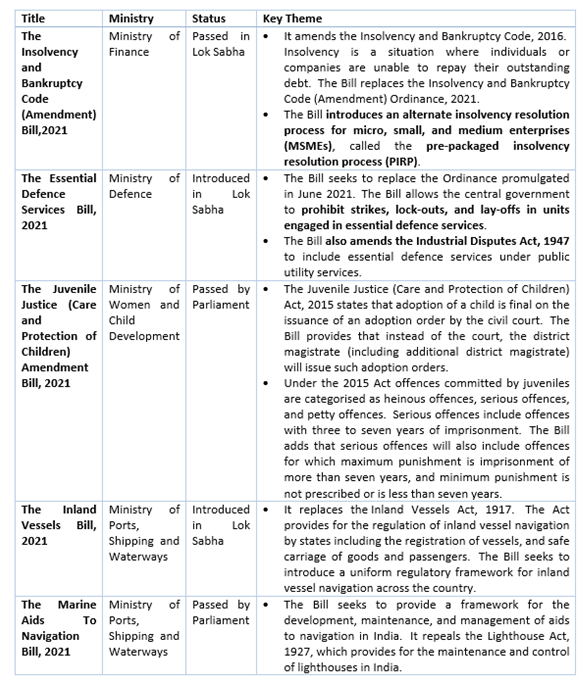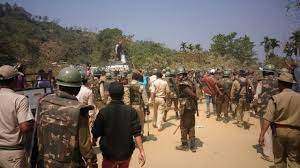Tuesday, 3rd August 2021
New IUCN Green status
In News
New IUCN Green status has been launched to focus on recovery efforts to give a fuller picture of threats to plant and animal populations

About the Green Status
- Complement Red List: The new framework aims to complement the IUCN Red List by providing a tool for assessing the recovery of species’ populations and measuring their conservation success. Green Status of Species outputs will be incorporated into the Red List in the coming years.
- Plot path of Recovery: By analysing a species’ historical population size, present-day distribution, the success of previous conservation efforts and viable habitat, the new standard will allow researchers to plot a path to recovery for some of the one million species threatened with extinction on Earth, largely through human activities.
- A relative measurement: Extinction risk, which we’ve used to measure conservation progress for decades, is a very absolute thing. A species is either at risk of extinction or it’s not. Recovery, however, is relative. Every species exists in different abundances and different distributions across the planet, so recovery has to be measured relatively.
- Future conservation planning: The IUCN green status will help inform conservation plans and steer action to meet national and international goals for 2030 and beyond.
- Optimistic Approach: Warnings of imminent extinctions are not the only way to catalyse conservation efforts. An optimistic vision of species conservation that presents a road map on how to conserve a species and achieve its recovery also is necessary to incentivize positive conservation actions and programmes.

Sources:
Decommissioning coal power plants
In News
Decommissioning coal power plants older than 25 years can save Rs 37,000 crore: Study
About the News
- Two independent studies, one by Council on Energy, Environment and Water (CEEW) and other by CEEW Centre for Energy Finance (CEF) examined performance of thermal power plants during the 30 months preceding the COVID-19 pandemic.
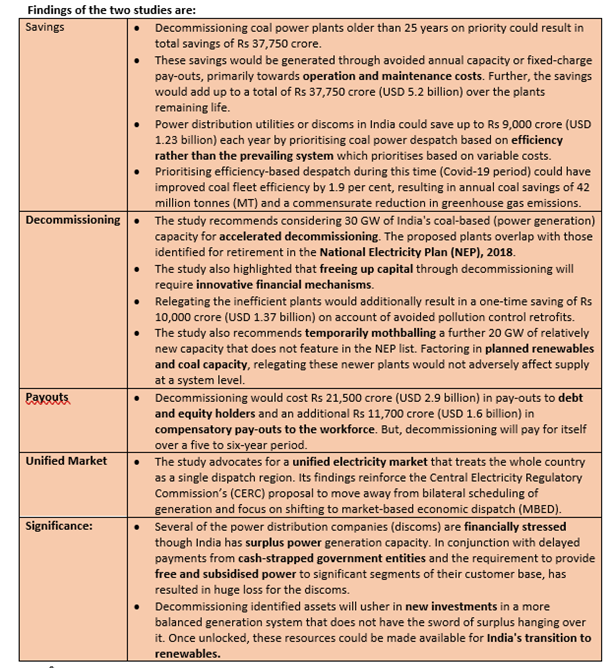
Sources:
NEET’s All India Quota
In News: The Centre has announced 27 per cent reservation for OBCs and 10 per cent reservation for the economically weaker section (EWS) in the All-India Quota (AIQ) scheme for undergraduate and postgraduate medical/dental courses in state medical and dental colleges from the current 2021-22 academic year onward.
All India Quota (AIQ) Scheme:
- The AIQ scheme was introduced in 1986 under the directions of the Supreme Court to provide domicile-free merit-based opportunities to students from any state to aspire to study in a good medical college in another state.
- There was no reservation in the AIQ scheme up to 2007 after which the Supreme Court introduced a reservation of 15 per cent for SCs and 7.5 per cent for STs in the AIQ scheme.
- Remaining chunk of the seats in state medical/dental colleges is reserved for students domiciled in their respective states.
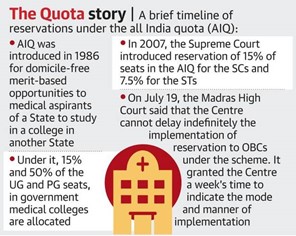
How is the Recent Reservation handy?
- When the Central Educational Institutions (Reservation in Admission) Act became effective in 2007, providing for uniform 27% reservation to the OBCs, the same was implemented in all the Central Educational Institutions but not extended to the AIQ seats of State medical and dental colleges.
- The 10% EWS quota under the Constitution (One Hundred and Third Amendment) Act, 2019, too, has been implemented in central educational Institutions, but not in the National Eligibility-cum-Entrance Test (NEET) AIQ for state institutions.
- This decision would benefit nearly 1,500 OBC students in MBBS and 2,500 OBC students in postgraduation, and around 550 EWS students in MBBS and around 1,000 EWS students in postgraduation every year.
Source:
- OBC, EWS get quotas in all-India seats of state medical, dental colleges
- Health Ministry announces 27% reservation for OBCs, 10% for EWS in national quota medical seats
- DNA Explainer: OBC, EWS reservation in medical colleges under AIQ - what it means and how it will work?
- Explained: NEET’s All India Quota, and OBC & EWS reservation
BRICS Counter Terrorism Action Plan
In News
The BRICS Counter Terrorism Action Plan was finalised at the 6th meeting of the BRICS Counter Terrorism Working Group (CTWG) held recently under the Chairmanship of India.
About the News
- The BRICS Counter Terrorism Action Plan contains specific measures to implement the BRICS Counter Terrorism Strategy adopted by BRICS Leaders in 2020.
- The Action Plan is aimed at further strengthening result-oriented cooperation between BRICS countries in areas such as preventing and combating terrorism, radicalisation, financing of terrorism, misuse of internet by terrorists, curbing travel of terrorists, border control, protection of soft targets, information sharing, capacity building, international and regional cooperation.
What are the Factors contributing to rise in Terrorist activities?
Terrorism is an ever-growing global threat that affects all nations. It has become an area of immense concern as the terror groups have evolved in their methods of influencing and building support bases and there after carry out attacks on in various parts of the world. It is a persistent global threat that knows no border, nationality, or religion, and is a challenge that the international community must tackle together.
- Cross-Border Issues: Terrorist activities carried out from parties/countries in the bordering country. Example, Pakistan aids and abets cross- border terrorism targeted against India which endangers security and stability not only of India.
- Terror Financing: The funds may come from legal sources, such as legitimate businesses, government funding, and religious or cultural organizations, or from illegal sources, such as drug trafficking, kidnapping, and government corruption. Terrorist organisations have also begun to exploit the anonymity afforded by blockchain technology for fundraising and finances.
- Radicalization of Youth: Young people are targeted both by recruitment and radicalization to violent extremist organizations and in terrorist attacks. Grievances and perceptions of socio-economic exclusion may in some cases facilitate the process of radicalization of mindsets and recruitment into extremist groups. Such grievances may—in combination with primary drivers such as the presence of recruiters in communities— contribute to radicalization.
- Misuse of Internet by terrorist groups: The use of the Internet to further terrorist purposes disregards national borders, amplifying the potential impact on victims. Various online means are being utilised by terrorist organisations to recruit their followers, communicate with their supporters, or promote their activities. Besides the dark web, social media has been used to spread violence, showcase various terror attacks live.
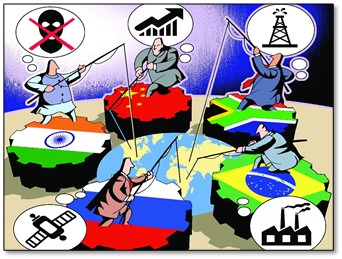
Roadblocks under BRICS in its fight against Terrorism
- Differences with Sovereign’s policies: BRICS members amongst themselves have very limited common interests, specifically when it comes to national and regional security Much of BRICS’s wordings on terrorism are similar to those of other multilateral forums, where only broad counter-terror narrative is proposed, which does not overlap with an individual’s state’s sovereign foreign policy and geopolitics.
- China’s intransigence: This factor has often made it difficult to designate terror-operatives at various international fora. It may be recalled that a number of Pak-based leaders of terror outfits have been listed by UNSC after challenging negotiations. It may be recalled that while China has acted tough on terrorism on its soil it has often shielded Pakistan during efforts by international bodies to act Pakistan’s use of terror as an instrument of state policy.
- Difficult to reach a consensus: The BRICS works by consensus and unlike many other global bodies has a concrete delivery mechanism that includes a Bank and disbursement of finance for development projects. There are clear challenges in bringing terrorism as a point of commonality between the member states. So, it becomes difficult to undertake concrete decisions as consensus is difficult to be achieved.
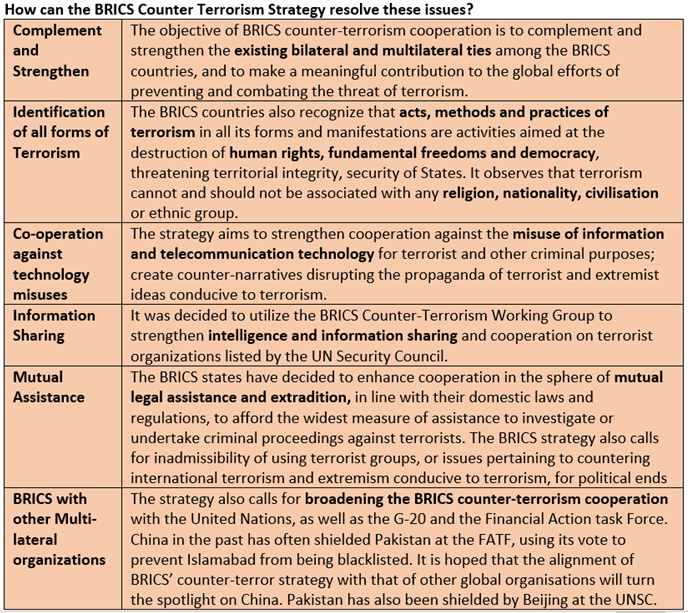
Conclusion
The BRICS nations have within them not just a representation of close to forty percent of the world population, but a significant number of them are young people who are a growing segment of the global internet/ social media community. Together the BRICS face similar challenges and opportunities. As they find more commonalities on their view on global issues, it is hoped that they would be able to build a collaborative approach to achieving their goals.
Question: Discuss the factors that contribute to increase in terrorist activities. How can the BRICS Counter Terrorism Strategy help counter this increase?
Sources:
- BRICS: Counter-terror strategy adopted at summit puts the onus on China
- Counter-terror strategy & multilateral reforms to top agenda of India's BRICS Presidency
- 6th Meeting of the BRICS Counter Terrorism Working Group
- India’s diplomacy to counter terror: Multilateral forums need regional success first
- BRICS Summits and Outlook on Terrorism
- Brazil: Extremism and Terrorism
- China says Xinjiang still faces terrorism and extremism threats despite no attack for 4 years
- BRICS identifies counter-terrorism as one of priority areas
- India and its BRICS dilemmas
- The Terrorist Threats Against Russia and its Counterterrorism Response Measures
This Day in History - Christopher Columbus
On August 3, 1492, Italian explorer Christopher Columbus started his voyage across the Atlantic Ocean. Columbus reasoned that since the world is round, he could sail west to reach “the east” (the lucrative lands of India and China). Columbus made it to what is now the Bahamas in 61 days. He initially thought his plan was successful and the ships had reached India. In fact, he called the indigenous people “Indians,” an inaccurate name that unfortunately stuck. Columbus called his plan as ‘Enterprise of the Indies’.

Sources:
Image of the Day - Light Echoes from behind a black hole
This is a simulated image of light echoes from behind a black hole. For the first time ever, scientists have seen the light from behind a black hole. In a new study, researchers observed the light from behind a black hole that’s 10 million times more massive than our sun and lies 800 million light-years away. The team spotted an X-ray flare that was so bright that some of the light reflected on the gas falling back into the black hole. The light "echo" was first predicted by Albert Einstein in his general theory of relativity, published in 1916. They also hope to better understand black hole coronas and explore how the corona of a black hole is capable of producing these bright X-ray flares.

Source:
Hunger Hotspots
- Context: The Food and Agriculture Organization of the United Nations (FAO) and the World Food Programme (WFP) have released a report on “Hunger Hotspots”.
- The report warns that in 23 countries and situations, acute food insecurity is likely to further deteriorate in the outlook period from August to November 2021.
- Conflict, climate extremes and economic shocks (including secondary impacts of the COVID-19 pandemic and natural hazard risks) are primary drivers of acute food insecurity.
- The report notes that over 41 million people worldwide are now at risk of falling into famine or famine-like conditions, unless they receive immediate life and livelihood-saving assistance.
- Ethiopia and Madagascar are new highest-alert hotspots.
- India does not feature in the list of these hotspots.
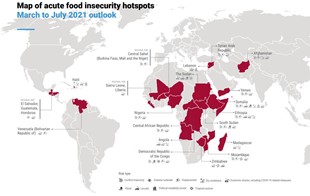
Source:
- Hunger Hotspots: FAO-WFP early warnings on acute food insecurity, August to November 2021 Outlook
- UN warns hunger is expected to rise in 23 global hotspots
- New and old challenges: Conflict, climate change and COVID-19 impacts on rising acute food insecurity
Image Source:
Ashwagandha (AG) in Covid Recovery
- Context: The Ministry of Ayush has collaborated with the U.K.'s London School of Hygiene and Tropical Medicine (LSHTM) to conduct a study on ‘Ashwagandha’ for promoting recovery from COVID-19.
- ‘Ashwagandha’ (Withania somnifera), commonly known as ‘Indian winter cherry’, is a traditional Indian herb used in of Indian Ayurvedic system of medicine.
- It boosts energy and makes the immune system stronger.
- It is classified as an adaptogen, meaning that it can help the body to manage stress.
- It can boost brain function, lower blood sugar and cortisol levels, and help fight symptoms of anxiety and depression.
- Ashwagandha has shown clinical success intreating both acute and chronic rheumatoid arthritis.
- Recent placebo controlled trials of AG in humans in India have demonstrated its efficacy in reducing anxiety and stress, improving muscle strength and reducing symptoms of fatigue in patients treated for chronic conditions.
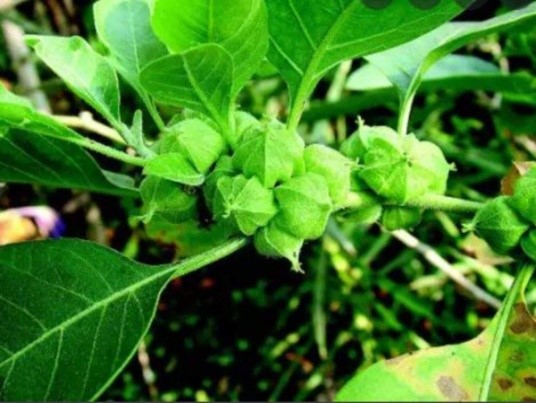
Source:
- India, U.K. to conduct clinical trials of ‘Ashwagandha’ for promoting recovery from COVID-19
- An Overview on Ashwagandha: A Rasayana (Rejuvenator) of Ayurveda
- 12 Proven Health Benefits of Ashwagandha
- India, UK to conduct clinical trials of Ashwagandha for promoting recovery from Covid-19
Delhi - Alwar RRTS Project
- Context: A Supreme Court-appointed committee has recommended the construction of a stretch of the proposed Delhi-Alwar high speed rail corridor under the Aravali Biodiversity Park and the extended ridge area.
- The regional rapid transit system (RRTS) is a 164-km rapid rail corridor, which will be a mix of elevated tracks and tunnels constructed by the National Capital Region Transport Corporation (NCRTC).
- It is expected to improve the air quality in Delhi/NCR (National Capital Region), because the share of public transport is expected to increase.
- Road traffic congestion will ease with a better transport network and the project will address regional connectivity issues and develop an efficient multimodal transport system connecting Delhi-NCR with road, rail and air.
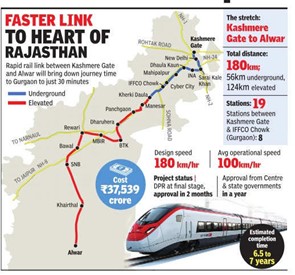
Source:
Halam Community
- Context: Clashes have taken place recently between Bru people living in the Casco Relief Camp in Damcherra Area in Tripura and Halam community over the possession of forest land in the area.
- Ethnically Halam communities of Tripura belong to the Kuki-Chin tribes of Tibeto-Burmese ethnic group.
- Their language is also more or less similar to that of Tibeto-Burman family.
- Halams are also known as Mila Kuki, though they are not at all Kukis in terms of language, culture and living style.
- Halams are divided into several sub-clans which is referred as “Barki-Halam” some of which include Koloi, Korbong, Kaipeng, Bong etc.
- As per 2011 Census their total population is 57,210 and distributed throughout the State.
- Halams live in typical “Tong Ghar” specially made of bamboos and Changrass (thatch).
- Apart from plain land cultivation, they practice Jhum cultivation.
- Hi-Hook dance of the Halams is the most popular dance of the community.
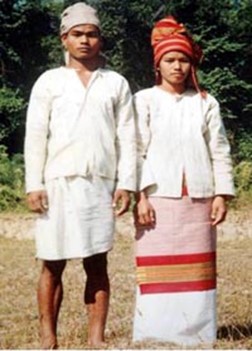
Source:
Image Source:
Solution for disruption of Parliament: More working days-IE
Essence: The article starts by giving the reasons for the disruptions of the past four sessions of the Parliament. It talks about the 2001 conference to discuss the discipline and decorum in legislatures.
A resolution was passed to increase the number of working days to reduce disruptions.
The author further discusses why despite this resolution such disruptions of sessions are still happening. He explains what needs to be done beyond increasing the number of working days by giving the example of the functioning of the British parliament.
Why you should read this article?
- Parliament functioning and conduct of business of the Parliament is a part of the syllabus.
- This article goes into the reasons, discusses solutions, and provides a case study for effective functioning of the parliament.
Source:
Criminalizing welfare issues-TH
Essence: Supreme court observes the need of welfare response instead of criminalizing welfare issue in response to a petition seeking for restraining beggars from begging to avoid the spread of COVID-19. Before criminalizing welfare issues, we need to see, first, whether issue could be better addressed with a welfare response. Second, addressing the underlining issues making people susceptible to exploitation and give them a legitimate way out of such work. Focusing on the welfare aspect of exploitative practices shed light on structural forms of impoverishment evidence & failure of the government and the society. Now it is crucial to question whose interests the law does serve.
Why should you read this article?
- To get an overview of criminalization of welfare issue and challenges associated.
- To know what possible steps should be taken to tackle the issue.
Source:
Making a case for Indo-Abrahamic accord-IE
Essence: The article highlights the situation in West Asia- Israel and UAE reconciliation and includes the perspective of important countries like Turkey and Greece in the region. Turkey has boundary disputes with Greece and is more aligned with interests of Pakistan. On the other hand, India and Greece have created greater cooperation in multiple spheres of economy and strategy. Iran and Turkey could pose greater threat to the West Asia region rather than Israel.
The strategy shouldn’t be to view middle-east through the eyes of religion but to look at the participants with the perspective of trade, strategy, security concerns and progress.
Why you should read this article?
- Understand the nuances of international relations from the perspective of strategy
- Understand the role of religion amongst countries
Source:
Conquering the mind is like conquering the world
Background to Raven Saunders
- Raven Saunders is an American track and field athlete who competes in the shot put and discus throw.
- Her life in 2018 was different.
- She struggled with money, her school life wasn’t easy, injuries were piling up and her performances were going awry. She witnessed a lot of stigma and mental stress.
- She was suffering from depression, anxiety and post-traumatic stress syndrome and was about to commit suicide
Medal:
- In 2021, she participated in Olympics and won a silver medal in shot put.
- Life at times feels unjust, sad and of no consequence if we can keep the heads up and walk the difficult path throughout, we always win.
Life lessons:
- Never Give up, Patience as virtue.
- There is a light at the end of tunnel.
Source:
Share the article
Get Latest Updates on Offers, Event dates, and free Mentorship sessions.

Get in touch with our Expert Academic Counsellors 👋
FAQs
UPSC Daily Current Affairs focuses on learning current events on a daily basis. An aspirant needs to study regular and updated information about current events, news, and relevant topics that are important for UPSC aspirants. It covers national and international affairs, government policies, socio-economic issues, science and technology advancements, and more.
UPSC Daily Current Affairs provides aspirants with a concise and comprehensive overview of the latest happenings and developments across various fields. It helps aspirants stay updated with current affairs and provides them with valuable insights and analysis, which are essential for answering questions in the UPSC examinations. It enhances their knowledge, analytical skills, and ability to connect current affairs with the UPSC syllabus.
UPSC Daily Current Affairs covers a wide range of topics, including politics, economics, science and technology, environment, social issues, governance, international relations, and more. It offers news summaries, in-depth analyses, editorials, opinion pieces, and relevant study materials. It also provides practice questions and quizzes to help aspirants test their understanding of current affairs.
Edukemy's UPSC Daily Current Affairs can be accessed through:
- UPSC Daily Current Affairs can be accessed through Current Affairs tab at the top of the Main Page of Edukemy.
- Edukemy Mobile app: The Daily Current Affairs can also be access through Edukemy Mobile App.
- Social media: Follow Edukemy’s official social media accounts or pages that provide UPSC Daily Current Affairs updates, including Facebook, Twitter, or Telegram channels.

